Abstract
Aromatic heterocycles are ubiquitous building blocks in bioactive natural products, pharmaceutical and agrochemical industries. Accordingly, the carborane-fused heterocycles would be potential candidates in drug discovery, nanomaterials, metallacarboranes, as well as photoluminescent materials. In recent years, the transition metal catalyzed B-H activation has been proved to be an effective protocol for selective functionalization of B-H bond of o-carboranes, which has been further extended for the synthesis of polyhedral borane cluster-fused heterocycles via cascade B-H functionalization/annulation process. This article summarizes the recent progress in construction of polyhedral borane cluster-fused heterocycles via B-H activation.
1. Introduction
Icosahedral carboranes are a class of carbon-boron molecular clusters with three dimensional aromaticity analogues to benzene, the features of high boron content, extraordinary thermal and chemical stability, and synthetic flexibility make the carborane derivatives be a kind of important building blocks in functional materials [1,2,3,4], key frameworks in pharmaceuticals [5,6,7,8] and ligands in organometallic chemistry [9,10,11,12,13]. Therefore, the selective functionalization of carboranes has attracted considerable interest from chemists [14,15,16,17,18].
In recent years, inspired by the C-H activation for direct functionalization of carbon-based molecules, the transition metal-catalyzed B-H activation has emerged as a powerful strategy for selective functionalization of o-carboranes and resulted in much advancement [19,20,21,22,23,24,25,26,27,28,29,30,31,32,33,34,35,36,37,38,39,40]. This succinct synthetic strategy offers an efficient protocol for selective functionalization of carboranes, and lead to a class of previously unavailable three dimensional carborane derivatives.
Aromatic heterocycles are ubiquitous building blocks in bioactive natural products, pharmaceutical and agrochemical industries. Based on the three dimensional aromaticity of carborane analogues to benzene, the carborane fused heterocycles would be potential synthons in designing drug candidates and molecular imaging regents for targeted radionuclide therapy [5,41,42]. This article summarizes the recent progress in construction of carborane-fused heterocycles via transition metal-catalyzed B-H activation, and the synthesis of carborane-fused heterocycles and carbocycles via substitution reaction or cycloaddition reaction with cage C-H bonds not included.
2. Synthesis of o-Carborane-Fused Heterocycles
Because of the 10 B-H bonds of o-carborane are not fully equal and the electrophilic reactivity is reduced in the following order: B(9,12) > B(8,10) > B(4,5,7,11) > B(3,6), which makes the functionalization of specific boron vertex to be a challenging subject [43,44]. Inspired by the transition metal catalyzed C-H activation of arenes and the three dimensional aromaticity of o-carborane analogues to benzene, by utilizing the palladium catalyzed electrophilic B-H activation, Cao and coworkers disclosed a selective arylation of B(8)-H and B(9)-H bonds of o-carboranes with iodobenzene [45]. Almost at the same time, the palladium-catalyzed intramolecular B-H/CAr-Br coupling for synthesis of o-carborane-fused dihydroindenes was reported by Xie group [46]. These pioneering works opened the door for selective functionalization of o-carboranes via B-H activation and further extend to polyhedral borane clusters [18].
In 2018, Xie group disclosed a rhodium-catalyzed cascade cyclization of carboranyl N-arylimines with vinyl ketones for synthesis of o-carborane-fused cyclopenta[b]quinolines via sequential C-H/B-H activation [47]. This reaction displays well the compatibility for various substituents and gives a series of unprecedented o-carborane-fused cyclopenta[b]quinolines (Figure 1).
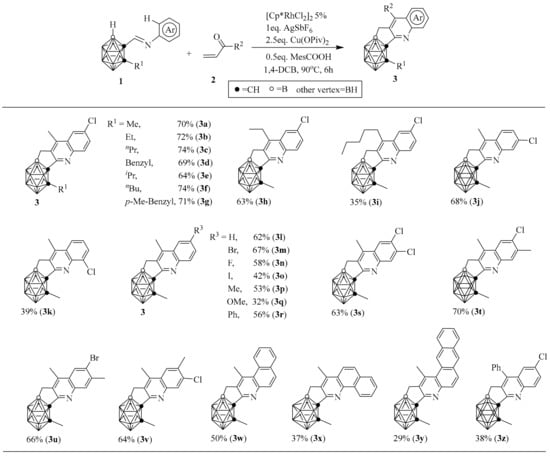
Figure 1.
Synthesis of o-carborane-fused cyclopenta[b]quinolines.
Mechanism studies indicate that the activation of cage B-H bond is preferred over the aryl C-H bond by isolating the key intermediate D. Based on the control experiment results, a plausible mechanism involving selective B-H activation, alkene insertion, nucleophilic cyclization, C-H activation, nucleophilic cyclization, dehydration and oxidative aromatization was proposed (Scheme 1).
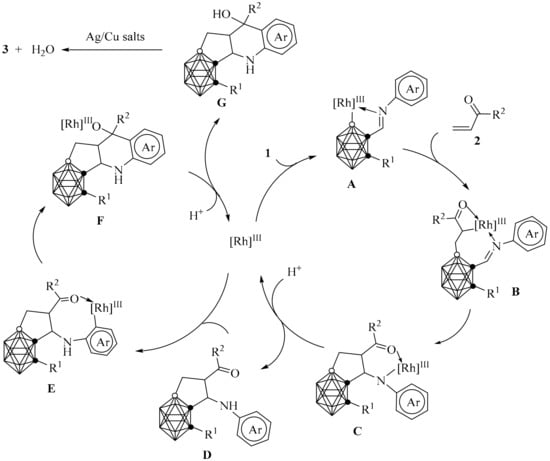
Scheme 1.
Proposed mechanism for rhodium-catalyzed cascade cyclization of carboranyl N-arylimines with vinyl ketones.
Based on the directing group guided/transition metal-catalyzed B-H activation for selective functionalization of o-carboranes, the copper catalyzed [4+2] annulation of carboranyl amides with internal alkynes for synthesis of o-carborane-fused pyridones were accomplished under the assistance of 8-aminoquinoline (Figure 2) [48]. Mechanism studies suggest a CuIII-catalyzed B-H activation based on the isolation and structural identification of a stable CuI intermediate. This is the first example for copper-catalyzed selective B-H activation of o-carborane, and offers an alternative catalytic active species for functionalization of o-carboranes and boron clusters.
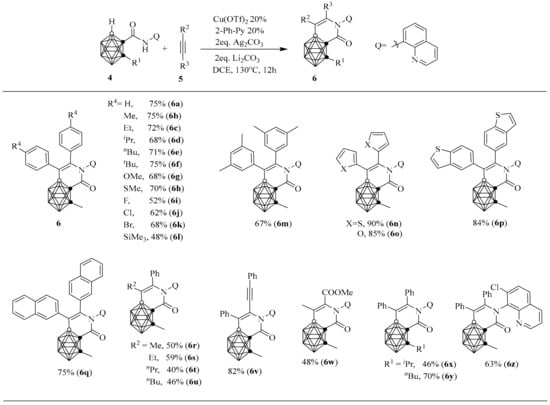
Figure 2.
Synthesis of o-carborane-fused pyridones.
Recently, by employing a traceless carboxylic acid as directing group, the iridium-catalyzed cascaded dehydrogenative cross coupling of B-H/C-H and B-H/N-H bonds for synthesis of carborano-isoquinolinones was developed in Xie’s group [49]. This reaction represents the most effective approach for synthesis of unprecedented carborano-isoquinolinones with available benzamides and provides important references for construction of o-carborane-fused heterocycles via dehydrogenative coupling process (Figure 3).
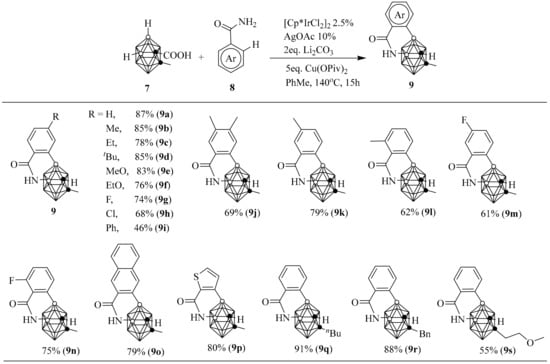
Figure 3.
Synthesis of carborano-isoquinolinones.
This cascade cross coupling could be stopped at the first B-H/C-H coupling step and gives a series of α-carboranyl benzamides, which indicates the forming of B-C bond is preferential over B-N bond. Cyclic voltammetry studies suggest the IrV should be the key species for the electrophilic C-H metallation and B-N reductive elimination steps, and a mechanism featured with Ir-nitrene species was proposed.
3. Synthesis of [CB11]−-Fused Heterocycle
According to the carboxylic acid directed selective B-H activation of o-carboranes [30,31,32,33,34,35,36,37], by introducing carboxylic acid into cage carbon of monocarba-closo-dodecaborate (CB11−), the iridium-catalyzed B-H activation/alkenylation/annulation of CB11− cluster with diarylacetylenes for synthesis of 3D analogues of isocoumarins was accomplished in Duttwyler’s group [50]. This transformation displays broad substrate scope for kinds of symmetric diarylacetylenes as well as unsymmetric internal alkynes (Figure 4). A carboxylic acid-assisted IrI/IrIII catalytic cycle for B-H activation/alkyne insertion was proposed based on the isolation and control experiments of IrIII intermediate.
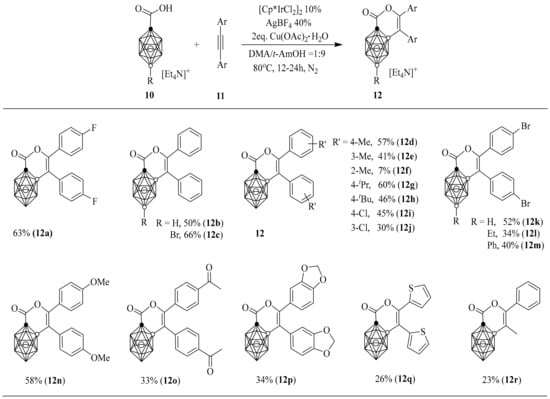
Figure 4.
Synthesis of 3D analogues of isocoumarins.
4. Synthesis of [B12]2−-Fused Heterocycles
The dodecahydro-closo-dodecaborate dianion [B12H12]2− is an icosahedral cluster with 12 identical B-H vertices, which make the selective boron functionalization of dodecaborates remains a major synthetic challenge in controlling the degree of substitution and regioselectivity. Traditional methods for B-H functionalization of closo-dodecaborates primarily rely on the iodinated precursors [51,52]. According to the transition metal catalyzed B-H activation of o-carboranes, Duttwyler and coworkers disclosed a rhodium-catalyzed double B-H activation of dodecaborate anion by employing ureido as directing group for the first time [53], which offers an efficient protocol for the synthesis of dodecaborate-fused oxazoles via one pot alkenylation/annulation process (Figure 5). Mechanism studies indicate the alkenylation occurs prior to annulation in this one pot transformation, and a plausible mechanism involving RhI/RhIII catalyzed dual B-H activation was proposed based on the isolation of a rhodium agostic intermediate.

Figure 5.
Synthesis of dodecaborate-fused oxazoles.
Later, the same group further extended the cascade alkenylation/annulation of dodecaborates with amide as directing group [54]. This transformation displays broad functional group tolerance and complete cage regioselectivity, and a series of dodecaborate-fused oxazoles were synthesized with moderate to good yields (Figure 6). Importantly, the above synthesized dodecaborate-fused oxazoles displayed blue emission in solid state, which would be potential candidates for the application in photoluminescent materials.
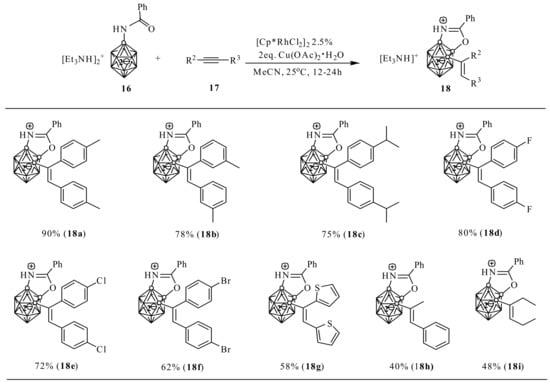
Figure 6.
Synthesis of dodecaborate-fused oxazoles with amide as directing group.
Interestingly, by replacing the alkyne with alkene, the cascade alkylation/annulation of dodecaborates amide was also proceed well in acetone and gives a series of unprecedented alkyl-substituted dodecaborate-fused oxazoles (Figure 7). The resulted products show strong resemblance to antimicriobially active boron clusters, and have potential applications in medicinal chemistry [55].
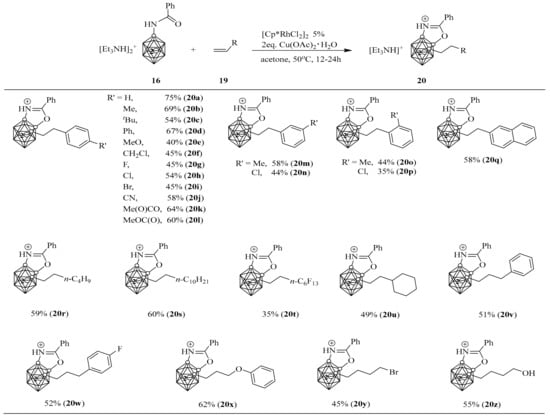
Figure 7.
Synthesis of alkyl-substituted dodecaborate-fused oxazoles.
5. Synthesis of nido-Carborane-Fused Heterocycles
Recently, by employing amide on cage B(9) of o-carborane, an unexpected one pot deboronation/cyclization for the synthesis of nido-7,8-carborane-fused oxazole by cooperation of Pd(OAc)2, AgOAc, and K2CO3 has been developed by Cao’s group [56]. A series of unprecedented nido-7,8-carborane-fused oxazoles have been synthesized with moderate to good yields (Figure 8), which opens a window for the synthesis of novel kinds of metallacarboranes and targeted radionuclide therapy reagents.
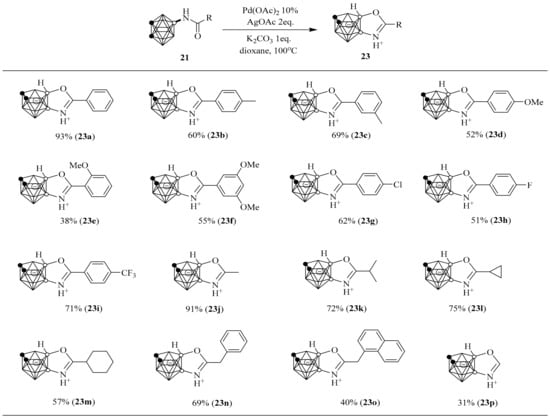
Figure 8.
Synthesis of nido-7,8-carborane-fused oxazoles.
To understand the mechanism, they have successfully isolated the key deboronated intermediate and unambiguously characterized by X-ray crystallographic analysis. Control experiments indicate that the deboronation reaction occurs first, and this one pot deboronation/cyclization reaction should be promoted by the cooperative effect of Pd(OAc)2, AgOAc, and K2CO3. Based on these results, a plausible mechanism involving a PdII-catalyzed B(8)-H activation, oxidation, and tautomerization of amide was proposed (Scheme 2).
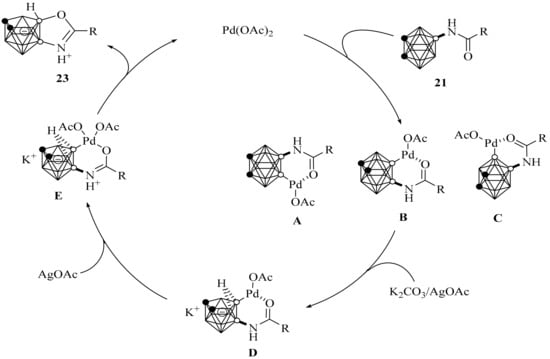
Scheme 2.
Plausible mechanism for synthesis nido-7,8-carborane-fused oxazoles.
6. Conclusions
The transition metal-catalyzed B-H activation as a novel synthetic strategy has been proved to be an effective protocol for selective functionalization of B-H bond of polyhedral borane clusters, which has been further extended to synthesis of polyhedral borane cluster-fused heterocycles via cascade B-H functionalization/annulation process. Because of the synthetic flexibility, aqueous stability and general robustness of polyhedral borane clusters, by combining the borane cluster with heterocycles would provide a library of potential candidates in drug discovery, nanomaterials, metallacarboranes, as well as photoluminescent materials. Despite the aforementioned strategies remarkable achievements have been made in recent years, exploring novel cascade reactions for the synthesis of diversified borane cluster-fused heterocycles are still anticipated in the future.
Author Contributions
Conceptualization, K.C.; writing—original draft preparation, K.C., C.-Y.Z., T.-T.X. and J.W.; writing—review and editing, X.-Y.W., W.-J.J., M.C. and J.Y. All authors have read and agreed to the published version of the manuscript.
Funding
This work was funded by Longshan academic talent research supporting program of SWUST (17LZX324, 18LZX305, 18LZXT02), and the Project of State Key Laboratory of Environment-friendly Energy Materials, SWUST (17fksy0102, 18fksy0206).
Conflicts of Interest
The authors declare no conflict of interest.
References
- Hosmane, N.S. Boron Science: New Technologies and Applications; CRC Press: Boca Raton, FL, USA, 2012. [Google Scholar]
- Kirlikovali, K.O.; Axtell, J.C.; Gonzalez, A.; Phung, A.C.; Khan, S.I.; Spokoyny, A.M. Luminescent metal complexes featuring photophysically innocent boron cluster ligands. Chem. Sci. 2016, 7, 5132–5138. [Google Scholar] [CrossRef] [PubMed]
- Mukherjee, S.; Thilagar, P. Boron clusters in luminescent materials. Chem. Commun. 2016, 52, 1070–1093. [Google Scholar] [CrossRef] [PubMed]
- Wu, X.; Guo, J.; Cao, Y.; Zhao, J.; Jia, W.; Chen, Y.; Jia, D. Mechanically triggered reversible stepwise tricolor switching and thermochromism of anthracene-o-carborane dyad. Chem. Sci. 2018, 9, 5270–5277. [Google Scholar] [CrossRef] [PubMed]
- Valliant, J.F.; Guenther, K.J.; King, A.S.; Morel, P.; Schaffer, P.; Sogbein, O.O.; Stephenson, K.A. The medicinal chemistry of carboranes. Coord. Chem. Rev. 2002, 232, 173–230. [Google Scholar] [CrossRef]
- Armstrong, A.F.; Valliant, J.F. The bioinorganic and medicinal chemistry of carboranes: From new drug discovery to molecular imaging and therapy. Dalton Trans. 2007, 4240–4251. [Google Scholar] [CrossRef]
- Issa, F.; Kassiou, M.; Rendina, L.M. Boron in drug discovery: Carboranes as unique pharmacophores in biologically active compounds. Chem. Rev. 2011, 111, 5701–5722. [Google Scholar] [CrossRef] [PubMed]
- Calabrese, G.; Daou, A.; Barbu, E.; Tsibouklis, J. Towards carborane-functionalised structures for the treatment of brain cancer. Drug Discov. Today 2018, 23, 63–75. [Google Scholar] [CrossRef]
- Xie, Z. Cyclopentadienyl-carboranyl hybrid compounds: a new class of versatile ligands for organometallic chemistry. Acc. Chem. Res. 2003, 36, 1–9. [Google Scholar] [CrossRef] [PubMed]
- Deng, L.; Xie, Z. Advances in the chemistry of carboranes and metallacarboranes with more than 12 vertices. Coord. Chem. Rev. 2007, 251, 2452–2476. [Google Scholar] [CrossRef]
- Yao, Z.-J.; Jin, G.-X. Transition metal complexes based on carboranyl ligands containing N, P, and S donors: Synthesis, reactivity and applications. Coord. Chem. Rev. 2013, 257, 2522–2535. [Google Scholar] [CrossRef]
- Spokoyny, A.M. New ligand platforms featuring boron-rich clusters as organomimetic substituents. Pure Appl. Chem. 2013, 85, 903–919. [Google Scholar] [CrossRef] [PubMed]
- Hosmane, N.S.; Maguire, J.A. Comprehensive Organometallic Chemistry III; Elsevier: Oxford, UK, 2007; Chapter 5; Volume 3. [Google Scholar]
- Qiu, Z. Recent advances in transition metal-mediated functionalization of o-carboranes. Tetrahedron Lett. 2015, 56, 963–971. [Google Scholar] [CrossRef]
- Duttwyler, S. Recent advances in B-H functionalization of icosahedral carboranes and boranes by transition metal catalysis. Pure Appl. Chem. 2018, 90, 733–744. [Google Scholar] [CrossRef]
- Quan, Y.; Qiu, Z.; Xie, Z. Transition-Metal-Catalyzed Selective Cage B-H Functionalization of o-Carboranes. Chem. Eur. J. 2018, 24, 2795–2805. [Google Scholar] [CrossRef] [PubMed]
- Zhang, X.; Yan, H. Transition metal-induced B-H functionalization of o-carborane. Coord. Chem. Rev. 2019, 378, 466–482. [Google Scholar] [CrossRef]
- Quan, Y.; Xie, Z. Controlled functionalization of o-carborane via transition metal catalyzed B-H activation. Chem. Soc. Rev. 2019, 48, 3660–3673. [Google Scholar] [CrossRef]
- Qiu, Z.; Quan, Y.; Xie, Z. Palladium-catalyzed selective fluorination of o-carboranes. J. Am. Chem. Soc. 2013, 135, 12192–12195. [Google Scholar] [CrossRef] [PubMed]
- Zhang, X.; Zheng, H.; Li, J.; Xu, F.; Zhao, J.; Yan, H. Selective catalytic B-H arylation of o-carboranyl aldehydes by a transient directing Strategy. J. Am. Chem. Soc. 2017, 139, 14511–14517. [Google Scholar] [CrossRef]
- Wu, J.; Cao, K.; Xu, T.-T.; Zhang, X.-J.; Jiang, L.; Yang, J.; Huang, Y. Palladium catalyzed regioselective mono-alkenylation of o-carboranes via Heck type coupling reaction of a cage B-H bond. RSC Adv. 2015, 5, 91683–91685. [Google Scholar] [CrossRef]
- Cao, K.; Xu, T.-T.; Wu, J.; Jiang, L.; Yang, J.; Xu, T.-T.; Wu, J. Palladium catalyzed/silver tuned selective mono-/tetra-acetoxylation of o-carboranes via B-H activation. Chem. Commun. 2016, 52, 11446–11449. [Google Scholar] [CrossRef]
- Xu, T.-T.; Zhang, C.-Y.; Cao, K.; Wu, J.; Jiang, L.; Li, J.; Li, B.; Yang, J. Palladium-catalyzed selective mono-chlorination of o-carboranes: Changing the concept of FeCl3 from Lewis acid to chlorine source in carboranes. ChemistrySelect 2017, 2, 3396–3399. [Google Scholar] [CrossRef]
- Xu, T.-T.; Cao, K.; Wu, J.; Zhang, C.-Y.; Yang, J. Palladium-catalyzed selective mono-/tetra-acetoxylation of o-carboranes with acetic acid via cross dehydrogenative coupling of cage B-H/O-H Bonds. Inorg. Chem. 2018, 57, 2925–2932. [Google Scholar] [CrossRef] [PubMed]
- Xu, T.-T.; Cao, K.; Zhang, C.-Y.; Wu, J.; Jiang, L.; Yang, J. Palladium catalyzed selective arylation of o-carboranes via B(4)-H activation: Amide induced regioselectivity reversal. Chem. Commun. 2018, 54, 13603–13606. [Google Scholar] [CrossRef] [PubMed]
- Lyu, H.; Zhang, J.; Yang, J.; Quan, Y.; Xie, Z. Catalytic regioselective cage B(8)-H arylation of o-carboranes via “cage-walking” strategy. J. Am. Chem. Soc. 2019, 141, 4219–4224. [Google Scholar] [CrossRef] [PubMed]
- Cao, K.; Zhang, C.-Y.; Xu, T.-T.; Wu, J.; Ding, L.-F.; Jiang, L.; Yang, J. Palladium catalyzed/counter ion tuned selective methylation of o-carboranes. J. Organomet. Chem. 2019, 902, 120956. [Google Scholar] [CrossRef]
- Wu, J.; Cao, K.; Zhang, C.-Y.; Xu, T.-T.; Ding, L.-F.; Li, B.; Yang, J. Catalytic Oxidative Dehydrogenative Coupling of Cage B-H/B-H Bonds for Synthesis of Bis(o-carborane)s. Org. Lett. 2019, 21, 5986–5989. [Google Scholar] [CrossRef] [PubMed]
- Xu, T.-T.; Cao, K.; Zhang, C.-Y.; Wu, J.; Jiang, L.-F.; Yang, J. Old Key Opens the Lock in Carborane: The in Situ NHC-Palladium Catalytic System for Selective Arylation of B(3,6)-H Bonds of o-Carboranes via B-H Activation. Org. Lett. 2019, 21, 9276–9279. [Google Scholar] [CrossRef]
- Quan, Y.; Xie, Z. Iridium catalyzed regioselective cage boron alkenylation of o-carboranes via direct cage B-H activation. J. Am. Chem. Soc. 2014, 136, 15513–15516. [Google Scholar] [CrossRef]
- Lyu, H.; Quan, Y.; Xie, Z. Palladium-catalyzed direct dialkenylation of cage B-H Bonds in o-carboranes through cross-coupling reactions. Angew. Chem. Int. Ed. 2015, 54, 10623–10626. [Google Scholar] [CrossRef]
- Lyu, H.; Quan, Y.; Xie, Z. Transition metal catalyzed direct amination of the cage B(4)-H Bond in o-carboranes: Synthesis of tertiary, secondary, and primary o-carboranyl amines. J. Am. Chem. Soc. 2016, 138, 12727–12730. [Google Scholar] [CrossRef]
- Lyu, H.; Quan, Y.; Xie, Z. Rhodium-catalyzed regioselective hydroxylation of cage B-H bonds of o-carboranes with O2 or Air. Angew. Chem. Int. Ed. 2016, 55, 11840–11844. [Google Scholar] [CrossRef] [PubMed]
- Quan, Y.; Tang, C.; Xie, Z. Palladium catalyzed regioselective B-C(sp) coupling via direct cage B-H activation: Synthesis of B(4)-alkynylated o-carboranes. Chem. Sci. 2016, 7, 5838–5845. [Google Scholar] [CrossRef] [PubMed]
- Quan, Y.; Xie, Z. Palladium-Catalyzed Regioselective Diarylation of o-Carboranes By Direct Cage B-H Activation. Angew. Chem. Int. Ed. 2016, 55, 1295–1298. [Google Scholar] [CrossRef] [PubMed]
- Lyu, H.; Quan, Y.; Xie, Z. Transition metal catalyzed regioselective B(4)-halogenation and B(4,5)-diiodination of cage B-H bonds in o-carboranes. Chem. Eur. J. 2017, 23, 14866–14871. [Google Scholar] [CrossRef]
- Quan, Y.; Lyu, H.; Xie, Z. Dehydrogenative cross-coupling of o-carborane with thiophenes via Ir-catalyzed regioselective cage B-H and C(sp2)-H activation. Chem. Commun. 2017, 53, 4818–4821. [Google Scholar] [CrossRef]
- Li, Y.; Jiang, Q.; Li, Y.; Yan, H.; Bregadze, V.I. Cobalt-Mediated B-H Activation and Cyclopentadienyl-Participated Diels-Alder Addition in the Reaction of a 16e CpCo Complex Containing an o-Carborane-1,2-dithiolato Ligand with HC≡C-C(O)Ph. Inorg. Chem. 2009, 49, 4–6. [Google Scholar] [CrossRef]
- Li, Y.; Jiang, Q.; Zhang, X.; Li, Y.; Yan, H.; Bregadze, V.I. Stepwise and Selective Carborane Substitution in the B (3,6) Positions of a 16e CpCo Half-Sandwich Complex Containing a Chelating ortho-Carborane-1,2-dithiolate Ligand. Inorg. Chem. 2010, 49, 3911–3917. [Google Scholar] [CrossRef]
- Li, H.; Bai, F.; Yan, H.; Lu, C.; Bregadze, V.I. Iridium(III)-Catalyzed Selective Sulfonamidation of o-Carborane with Sulfonyl Azide by Carboxylic Acid-Assisted B(4)-H Bond Activation. Eur. J. Org. Chem. 2017, 1343–1352. [Google Scholar] [CrossRef]
- Hawthorne, M.F.; Maderna, A. Applications of radiolabeled boron clusters to the diagnosis and treatment of cancer. Chem. Rev. 1999, 99, 3421–3434. [Google Scholar] [CrossRef]
- Bregadze, V.I.; Sivaev, I.B.; Glazun, S.A. Polyhedral boron compounds as potential diagnostic and therapeutic antitumor agents. Anti-Cancer Agents Med. Chem. 2006, 6, 75–109. [Google Scholar] [CrossRef]
- Potenza, J.A.; Lipscomb, W.N.; Vickers, G.D.; Schroeder, H. Order of Electrophilic Substitution in 1,2-Dicarbaclovododecaborane(12) and Nuclear Magnetic Resonance Assignment. J. Am. Chem. Soc. 1966, 88, 628–629. [Google Scholar] [CrossRef]
- Koetzle, T.F.; Lipscomb, W.N. Approximate wave functions for carboranes parametrized from self-consistent field model calculations. Inorg. Chem. 1970, 9, 2743–2748. [Google Scholar]
- Cao, K.; Huang, Y.; Yang, J.; Wu, J. Palladium catalyzed selective mono-arylation of o-carboranes via B-H activation. Chem. Commun. 2015, 51, 7257–7260. [Google Scholar] [CrossRef] [PubMed]
- Quan, Y.; Xie, Z. Palladium-Catalyzed Regioselective Intramolecular Coupling of o-Carborane with Aromatics via Direct Cage B-H Activation. J. Am. Chem. Soc. 2015, 137, 3502–3505. [Google Scholar] [CrossRef]
- Lyu, H.; Quan, Y.; Xie, Z. Rhodium catalyzed cascade cyclization featuring B-H and C-H activation: One-step construction of carborane-fused N-polyheterocycles. Chem. Sci. 2018, 9, 6390–6394. [Google Scholar] [CrossRef]
- Chen, Y.; Au, Y.K.; Quan, Y.; Xie, Z. Copper catalyzed/mediated direct B-H alkenylation/alkynylation in carboranes. Sci. China: Chem. 2019, 62, 74–79. [Google Scholar] [CrossRef]
- Au, Y.K.; Lyu, H.; Quan, Y.; Xie, Z. Catalytic Cascade Dehydrogenative Cross-Coupling of BH/CH and BH/NH: One-Pot Process to Carborano-Isoquinolinone. J. Am. Chem. Soc. 2019, 141, 12855–12862. [Google Scholar] [CrossRef]
- Lin, F.; Shen, Y.; Zhang, Y.; Sun, Y.; Liu, J.; Duttwyler, S. Fusing Carborane Carboxylic Acids with Alkynes: 3D Analogues of Isocoumarins via Regioselective B-H Activation. Chem. Eur. J. 2018, 24, 551–555. [Google Scholar] [CrossRef]
- Peymann, T.; Knobler, C.B.; Hawthorne, M.F. Synthesis of Alkyl and Aryl Derivatives of closo-B12H122- by the Palladium-Catalyzed Coupling of closo-B12H11I2- with Grignard Reagents. Inorg. Chem. 1998, 37, 1544–1548. [Google Scholar] [CrossRef]
- Himmelspach, A.; Finze, M.; Vöge, A.; Gabel, D. Cesium and Tetrabutylammonium Salt of the Ethynyl-closo-dodecaborate Dianion. Z. Anorg. Allg. Chem. 2012, 638, 512–519. [Google Scholar] [CrossRef]
- Zhang, Y.; Sun, Y.; Lin, F.; Liu, J.; Duttwyler, S. Rhodium(III)-catalyzed alkenylation-annulation of closo-dodecaborate anions through double B-H activation at room temperature. Angew. Chem. Int. Ed. 2016, 55, 15609–15614. [Google Scholar] [CrossRef] [PubMed]
- Zhang, Y.; Wang, T.; Wang, L.; Sun, Y.; Lin, F.; Liu, J.; Duttwyler, S. Rh(III)-Catalyzed Functionalization of closo-Dodecaborates via Selective B-H Activation: Bypassing Competitive C-H Activation. Chem. Eur. J. 2018, 24, 15812–15817. [Google Scholar] [CrossRef] [PubMed]
- Sun, Y.; Zhang, J.; Zhang, Y.; Liu, J.; van der Veen, S.; Duttwyler, S. The closo-dodecaborate dianion fused with oxazoles provides 3D diboraheterocycles with selective antimicrobial activity. Chem. Eur. J. 2018, 24, 10364–10371. [Google Scholar] [CrossRef] [PubMed]
- Zhang, C.-Y.; Cao, K.; Xu, T.-T.; Wu, J.; Jiang, L.; Yang, J. A facile approach for the synthesis of nido-carborane fused oxazoles via one pot deboronation/cyclization of 9-amide-o-carboranes. Chem. Commun. 2019, 55, 830–833. [Google Scholar] [CrossRef] [PubMed]
© 2020 by the authors. Licensee MDPI, Basel, Switzerland. This article is an open access article distributed under the terms and conditions of the Creative Commons Attribution (CC BY) license (http://creativecommons.org/licenses/by/4.0/).